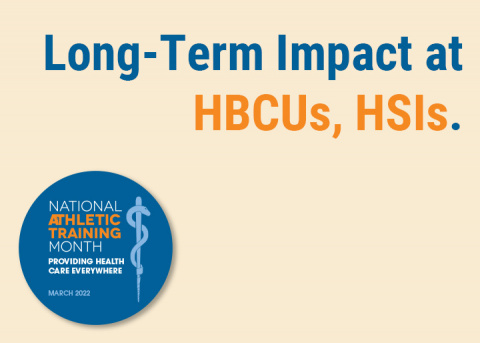
It's National Athletic Training Month! To showcase this year's theme, "Providing Health Care Everywhere," the NATA Now blog will highlight athletic trainers in a variety of settings. Learn about how they're increasing understanding of the profession and how you can, too.
Although colleges and universities are not a new setting for athletic trainers, their place there has always been impactful for the student athletes they treat and the students they teach about health care, especially at institutions in underserved or minoritized communities.
ATs at historically Black colleges and universities (HBCUs) and Hispanic-serving institutions (HSIs) are an important part of the health care and education system for student athletes as well as diversifying the profession.
By working in HBCUs and HSIs, athletic trainers can be great promoters of the profession and of health care education among populations who often have negative stereotypes about health care. As athletic trainers for collegiate athletics, ATs are introducing Black and Hispanic student athletes to their skillsets as health care providers – they not only prevent, diagnose and treat injuries, they educate student athletes about their own health care.
NATA Intercollegiate Council for Sports Medicine HBCU Rep. Janah Fletcher, EdD, LAT, ATC, said this is a top priority for her. Fletcher is the head AT and assistant athletic director at North Carolina A&T State University, an HBCU with about 13,000 students.
“It’s huge – for some of our student athletes in this population, there hasn’t been a lot of health care or we may be the only health care providers that they see,” she said, adding there is often a lack of trust in the health care system, depending on their family background or personal experiences.
“We are teaching them about health care. We try to give them the tools they need when they leave here.”
HBCUs are colleges or universities that were established prior to 1964 with the principal mission of educating Black Americans. In 2020, there were 101 HBCUs located in 19 states, the District of Columbia and the U.S. Virgin Islands.
Many HBCUs face challenges with underfunding and resources, which makes access to health care important. A 2019 survey from the American Council on Education looking at historical legacy of inequitable funding and investments by federal and state governments found that public HBCUs rely on federal, state and local funding more heavily than their non-HBCU counterparts.
ICSM Community College Chair Jamie DeRollo, DAT, MBA, ATC, head athletic trainer at an HSI, Modesto Junior College, said that students who see ATs who look like them is beneficial when providing care and education about the profession. Modesto Junior College offers an associate’s degree path in sports medicine, that DeRollo said is a great stepping stone into athletic training education.
“It helps that [the student athletes] are seeing representation of themselves when they come to the athletic training facility and see athletic training students,” she said.
HSIs are defined as accredited, degree-granting, public or private nonprofit higher education institutions with 25% or more total undergraduate Hispanic or Latinx full-time equivalent student enrollment. Similar to HBCUs, HSIs face persistent underfunding, which can limit the targeted resources they provide to Hispanic learners.
DeRollo sees education as a large part of her role as an athletic trainer, as well. Small tasks, such as translating documents into Spanish, for patients and educating them on what ATs can do as health care providers is important.
DeRollo recommends the UndocuALLY training for health care providers, especially those serving Hispanic and Latino patients. The UndocuALLY training is used to increase skills to support undocumented students, and includes information on immigration history and federal and state laws and policies.
“Some people don’t realize the obstacles or detriments to social health that are out there for these populations,” she said. “Having these conversations and opening up people’s eyes is important to talk about it, even if they’re not experienced in it.”
Modesto Junior College’s athletic training program helps increase the awareness of athletic training as a career for Hispanic students, and DeRollo encourages athletic training students and the sports medicine team to interact with students on campus in engaging ways.
For example, before the COVID-19 pandemic, the athletic training program hosted a blood drive on campus, so students were able share information and interact with a bigger audience. DeRollo has also hosted “open house” events at the athletic training facility to increase awareness of the profession. She invites college administration and leaders, other staff and employees as well as local high school students.
Although NC A&T State University doesn’t have an athletic training program specifically, Fletcher collaborates with the kinesiology department and other local universities to increase exposure to athletic training. On campus, Fletcher works with athletic training student aides who volunteer time in the athletic training facility. This increases exposure to the full role of athletic trainers, Fletcher said.
“Some only see ATs on the field or at practice, which creates a disconnect between students and ATs in terms of what they really can do as health care providers. Athletic training having that opportunity for exposure [to young people] always helps us to grow as a profession,” Fletcher said.
On HBCU and HSI campuses, the athletic trainer’s ability to connect with students and athletes can increase awareness of the athletic training profession. With this exposure, the profession can continue to grow, better serving active people in all populations for the long term.
MORE NATM
The NATA National Athletic Training Month webpage offers a variety of resources to help raise awareness about the important work of athletic trainers, including a sample press release, media alert and press tip sheet.
You can also download the 2022 NATM poster with the “Providing Health Care Everywhere" theme. Additionally, download NATM logos and posters from years past.





